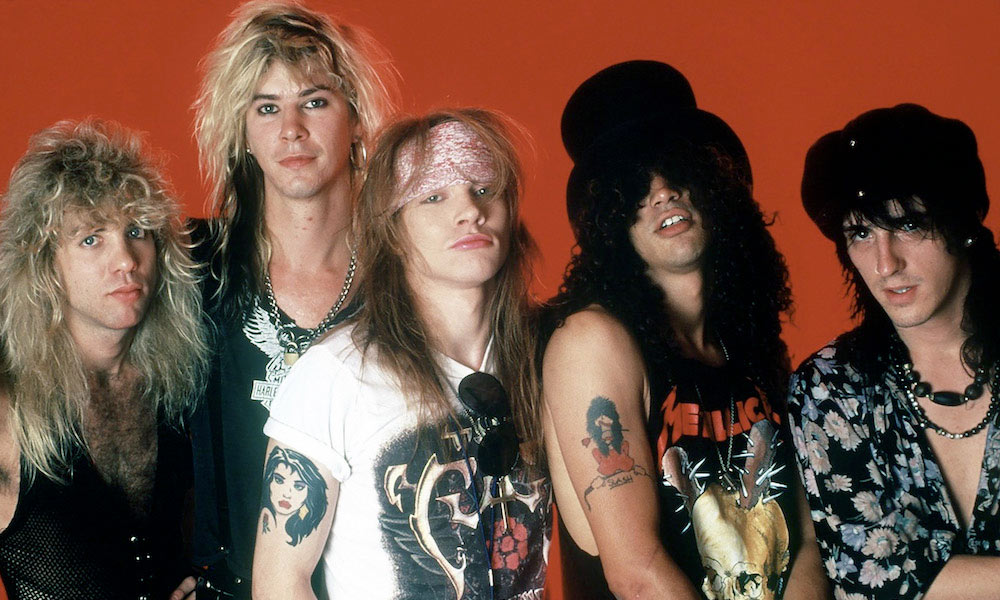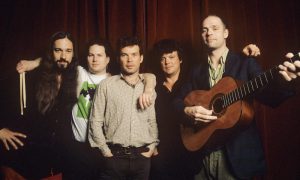Even by the music industry’s mercurial standards, Guns N’ Roses’ penchant for hedonism is legendary, with their love of the lifestyle quickly earning them the epithet “the most dangerous band in the world”. However, let’s put the sensationalism to one side for a while. The best Guns N’ Roses songs have seen the band put their inimitable stamp on rock history, and are the real reason we all love Axl and co so much.
Their multi-platinum debut album, Appetite For Destruction, and ambitious Use Your Illusion I and II sister sets are mandatory titles for self-respecting rock fans of all persuasions, while even the oft-overlooked Chinese Democracy demands some major reappraisal. They’ve done everything from cover “Knockin’ On Heaven’s Door,” originally by Bob Dylan, to anthems like “Coma” and “Get In The Ring.” They’ve toured with the likes of The Rolling Stones and Aerosmith. Indeed, since original Guns members Axl Rose, Slash, and Duff McKagan reunited for the massive Not In This Lifetime… Tour, this iconic outfit have shown us exactly why they’re still one of the few rock bands who still really matter.
Listen to the best of Guns N’ Roses on Apple Music and Spotify.
20: New Rose
It’s easy to pass over 1993’s The Spaghetti Incident? when reassessing Guns N’ Roses’ oeuvre, but as covers albums go, it’s a belter. Its tracklist also reveals plenty about GNR’s early influences, with the band delivering rousing versions of nuggets first recorded by pioneering punk and hard rock acts such as UK Subs, The Stooges, and The Professionals. Arguably its best moment is the crunching, Duff McKagan-sung version of The Damned’s punk classic “New Rose.” The song’s author, Brian James, later told Vive Le Rock, “It’s a great version of the song, the best I’ve heard.”
19: Move To The City
Prior to strapping in for Appetite For Destruction, the stratospheric rocket ride that would make them the biggest band in the world, the fledgling GNR released a bite-sized taster of things to come with the four-track Live?!*@ Like A Suicide EP late in 1986. Though not technically live (the crowd noise was actually swiped from 70s mega-festival Texxas Jam), the strictly limited-edition EP still bolstered the buzz around the band, and, in Izzy Stradlin’s Rolling Stones-esque ‘Move To The City’, it contained at least one underrated gem.
18: My Michelle
It’s hard to source a love song darker than Appetite For Destruction’s ‘My Michelle’. Though reputedly influenced by Elton John’s evergreen hit ‘Your Song’, this churning rocker, featuring a suitably chest-beating Axl Rose vocal, is considerably less bucolic, with its street-level lyric (“Your Daddy works in porno/Now that mommy’s not around/She used to love her heroin, but now she’s underground”) pulling few punches in its brutality. The song was penned about a friend of the band, Michelle Young, who told Classic Rock in 2014, “It was a strange thing to have influence my life. It’s amazing to see them play it live, that’s really special and cool, but when the song came out… It was never a blessing, let’s just say.”
17: Double Talkin’ Jive
One of several tracks from the sprawling Use Your Illusion I written and sung by rhythm guitarist Izzy Stradlin, the insistent, chugging “Double Talkin’ Jive” is a moody, atmospheric rocker par excellence, lifted even higher by Slash’s muscular electric guitar solo and his unexpectedly delicate flamenco-style part during the fade. The song’s ominous lyric “Found a head and an arm in a garbage can” refers to body parts that were actually discovered by the police in a dumpster near the studio the band was working in at the time.
16: Out Ta Get Me
Later described by Slash as GNR’s “big anarchy statement”, Appetite For Destruction’s “Out Ta Get Me” finds Axl Rose railing against the unwanted attention GNR members often faced from the authorities. “It’s just [about] being railroaded into something and trying to get out from underneath it,” Rose said in a 1987 Geffen Records press release. “You know – parents, teachers, preachers… everybody.” His band also supplied a suitably defiant backing track for this classic outsider’s anthem, with Slash and Izzy Stradlin both on fire throughout. “Izzy’s stuff was always easy to expand upon,” Slash later told Guitar Edge. “He would always have a classic line that you could make into some humongous riff. We just ripped into that lead line.”
15: Live And Let Die
Written by Paul and Linda McCartney and initially performed by Wings, “Live And Let Die” is still best known as the theme song of the 1973 James Bond movie of the same name. Widely regarded as the song’s definitive cover, however, GNR’s compelling, widescreen take of the track was one of Use Your Illusion I’s high points and was released as the album’s second single, cracking the Top 40 of the Billboard Hot 100. It later received a nomination for Best Hard Rock Performance at the 1993 Grammy Awards.
14: You Could Be Mine
Guns N’ Roses trailed the release of their two sprawling, simultaneously-released masterpieces, Use Your Illusion I and II, with “You Could Be Mine,” a vicious rocker equal to anything from Appetite For Destruction. On its own merits, the track became a sizeable transatlantic hit, but it went global as the theme to one of 1991’s biggest box-office smashes, James Cameron’s Terminator 2: Judgement Day. That landmark film’s star, Arnold Schwarzenegger, personally invited GNR for dinner to negotiate the use of “You Could Be Mine” in the movie.
13: Better
Truly the stuff of legend, GNR’s sixth album, 2008’s Chinese Democracy, reputedly cost more than $13 million to record and took almost a decade to create. Though Axl Rose is the only original Guns member to feature on the album, Chinese Democracy contains plenty of merit, and while its title track is also a contender among the best Guns N’ Roses songs, “Better” is surely the record’s crowning glory. Indeed, we can only concur with Rolling Stone’s verdict: “‘Better’ feels like classic Guns N’ Roses – Rose’s growling croon in the verses could have floated out of the Use Your Illusion sessions.”
12: Estranged
Highly personal to Axl Rose, Use Your Illusion II’s “Estranged” was written during the period following the annulment of the singer’s marriage to Erin Everly, who had provided the inspiration for GNR’s signature hit, “Sweet Child O’ Mine.” The singer made no bones about his loneliness and vulnerability in “Estranged” when he sang “When you’re talking to yourself and nobody’s home/You can fool yourself/You came in this world alone”. Clocking in at over nine minutes, the song was an epic on a scale similar to the celebrated “November Rain”, and while Axl was credited as its sole writer, Slash embroidered the track with some of his most sensitive and memorable fretwork. Rose acknowledged this in the UYI II credits, when he wrote, “Slash, special thanks for the killer guitar melodies.”
11: Nightrain
Prior to recording Appetite For Destruction, Guns N’ Roses lived a hand-to-mouth existence, living communally in an LA rehearsal space. Their unsigned status, however, was eased a little by the discovery of a cheap, yet powerful liquor named Night Train, which instantly became a band staple. Within weeks, this gut-rot elixir inspired the swaggering “Nightrain,” which – along with ‘Welcome To The Jungle’ – convinced Geffen A&R man Tom Zutaut to sign GNR to the label. “That song has a rhythm to it in the verses that from the start always made me go crazy,” Slash wrote in his autobiography. “When we had our huge stage later on, I’d run the length of it, jump off the amplifiers and lose it every single time we played it.”
10: Civil War
“Civil War” represented both an ending and a new beginning for Guns N’ Roses. The first song laid down during the Use Your Illusion sessions in the summer of 1990, it also marked Adler’s final studio session with the band. On the plus side, “Civil War” marked a new chapter in GNR’s remarkable story, for the song – an ominously atmospheric anti-war epic wherein Axl Rose mourns the loss of all-American icons such as John F Kennedy and Martin Luther King – was a major departure from Guns’ signature sleazoid hard rock. Bringing it to fruition served notice that the band had significantly upped the ante as they threw themselves into realizing Use Your Illusion I and II.
9: Don’t Cry
The second of Use Your Illusion’s epic, widescreen ballads, “Don’t Cry” actually pre-dates Appetite For Destruction, but it was held back after consensus decreed that “Sweet Child O’ Mine” did enough to give GNR’s legend-enshrining debut album a little pop sensibility. Axl Rose was especially enamored of the track, with Guns eventually recording different versions for Use Your Illusion I and II, respectively. Save for some alternate lyrics, there’s not much to tell them apart, though the single version (from Use Your Illusion I) is generally regarded as the definitive take. Either way, it’s a great track: a classic, smoldering love song elevated by one of Slash’s most timeless solos.
8: Mr. Brownstone
They say you should write about what you know, but sadly during the late 80s and early 90s, Guns N’ Roses’ classic line-up got rather too intimately acquainted with “Mr. Brownstone,” the title of which references both heroin and a favored local dope dealer. Part of the song’s inherent power is that it pulls no punches where drug use is concerned (“I used to do a little, but a little wouldn’t do it/So, the little got more and more”), but it’s also one of Appetite For Destruction’s most compelling compositions: an imperious blast of blues-tinged hard rock driven by Steven Adler’s infectious, Bo Diddley-esque beat.
7: Paradise City
The tales of excess that are associated with Guns N’ Roses’ history tend to overshadow the camaraderie the band enjoyed during their early days – a highly fertile period during which they wrote many of their classic songs. A case in point is “Paradise City,” an atypically optimistic classic rock anthem and one of GNR’s most recognizable songs, the bones of which the band wrote together in a rented van on the way back to LA from San Francisco. Appetite For Destruction’s fourth single and a transatlantic Top 10, “Paradise City” has served as Guns N’ Roses’ closing concert number for most of their career, and has been singled out by Slash as his all-time favorite song by the band.
6: Patience
Though it was only ever a stop-gap release, 1988’s GN’R Lies still went platinum in the aftermath of Appetite For Destruction’s release. In effect, an expanded EP – with the first side reprising the Live?!*@ Like A Suicide EP and the flip presenting four new acoustic tracks – GN’R Lies still had moments aplenty, and in “Patience” it harbored an absolute gem. Penned by Izzy Stradlin, this haunting ballad is one of the group’s very best, more than earning its US Top 5 placing as a standalone single in 1989. Though powered by acoustic guitars in the studio, an electric version of “Patience” has remained a staple of GNR tours ever since and was more recently covered by the late Chris Cornell.
5: It’s So Easy
Appetite For Destruction’s first single, and a quintessential GNR rocker, “It’s So Easy” was penned by bassist Duff McKagan, with help from his guitar-playing neighbor and band associate West Arkeen. Astonishingly, the song began life as a country-style tune which was given a radical makeover by GNR, who, as Axl Rose later revealed, was “doing the evil Iggy Pop over it”. As to the song’s lyrics, they relate to the then-penniless GNR scraping by with the help of various girlfriends. “It’s an account of a time all of us were going through,” McKagan said in a Geffen Records press release from 1987. “We didn’t have money, but we had a lot of hangers-on and girls that we could basically live off of. Things were just too easy.”
4: Rocket Queen
“Sweet Child O’ Mine” aside, most of Appetite For Destruction homes in on the darker, seedier underbelly of Hollywood. However, with the album’s closing track, “Rocket Queen,” GNR injected a little positivity with a song directed at two former female band associates who loyally supported them in their early days. The song’s title came from a name one of the girls, Barbie Von Grief, had devised for her own band. “They were the underdogs, 110 percent of the time,” she later recalled. “They were always the bad guys – so, of course, we wanted them to win.” “Rocket Queen” initially seems like a typical, braggadocio-fueled rocker, but its more reflective second section shows just how versatile and soulful a unit GNR could be.
3: Sweet Child O’ Mine
Like so many of GNR’s legendary early songs, their signature hit, “Sweet Child O’ Mine,” was written quickly, as inspiration struck during a spontaneous jam session at the band’s house on the Sunset Strip. Axl Rose then added an atypically intimate lyric based upon a poem he’d written for his then-girlfriend, Erin Everly. The band cut the track with Appetite For Destruction producer Mike Clink, who later told Q magazine, “That song made the hairs on my arms stand up, it was magical.” Showing that GNR could master poetic and vulnerable as effectively as their trademark, testosterone-fueled rock’n’roll, “Sweet Child O’ Mine’”s radio-friendly accessibility rewarded the band with their only US No.1 and it’s since been covered by artists as diverse as Carrie Underwood, Sheryl Crow, and The Black Eyed Peas.
2: November Rain
Often referred to as Axl Rose’s very own ‘Bohemian Rhapsody’, the legendary “November Rain” was the GNR frontman’s magnum opus in every sense of the term. Reputedly dating back to 1983 and demoed prior to the recording of Appetite For Destruction, Rose put every fiber of his being into this opulent creation couched in strings and grand piano which first appeared as Use Your Illusion I’s centerpiece in September 1991, but cemented its reputation as one of rock’s essential power ballads when released as a single in February 1992. Promoted with a suitably epic, big-budget video (apparently costing around $1 million to create), the near-nine-minute “November Rain” was the longest song ever to enter the US Billboard Hot 100. That did nothing to prevent it shooting to No.3 in the US and No.4 in the UK, and becoming GNR’s highest-charting single since “Sweet Child O’ Mine.”
1: Welcome To The Jungle
From its sleazy groove to the ferocious, stabbing guitars and Axl Rose’s menacing vocals, Appetite For Destruction’s opening track, “Welcome To The Jungle,” contains all the hallmarks of classic GNR. The song also played a crucial role in catapulting the band to fame after its famous video (which featured Indiana native Axl Rose as an out-of-towner getting his first taste of the Los Angeles streets) finally picked up heavy rotation on MTV, helping to send the album to No.1 in the US a year after its initial release. You could argue that “Welcome To The Jungle” lacks the across-the-board appeal of “Sweet Child O’ Mine” or the splendor of “November Rain,” but when it comes to choosing a song which bottles the sheer edge, danger, and unpredictability of Guns N’ Roses in four short minutes, then there really is no contest.
Have we missed one of the best Guns N’ Roses songs? Maybe you love Alice Cooper, so “The Garden” is your favorite, or you can’t live without “One In A Million.” Let us know in the comments section below.




